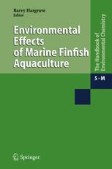Search
Search Results
-
The Sacca di Goro Lagoon and an Arm of the Po River
The Po di Volano canal–Sacca di Goro lagoon is a small hydrographic system partially located in the southern part of the Po River Delta. The total...
-
Development, Occurrence and Regulationof Antifouling Paint Biocides: Historical Review and Future Trends
Antifouling agents have been used on ships since the ancient Roman and Greek civilizations. A brief history is provided through to the demise of...
-
Worldwide Occurrence of Organotins from Antifouling Paints and Effects in the Aquatic Environment
Organotins belong to the most toxic pollutants for aquatic life known so far. Widespread contamination of harbors and areas with high ship**...
-
Role of Particle Sorption Properties in the Behavior and Speciation of Trace Metals in Macrotidal Estuaries: The Cadmium Example
The role of particles in the fate and speciation of trace metals in macrotidal estuaries was studied using a surface complexation model (MOCO)....
-
Antifouling Paint Booster Biocides: Occurrence and Partitioning in Water and Sediments
Following the ban on the use of tributyltin (TBT) in antifouling, several organic booster biocides have been used in conjunction with copper in...
-
New Trends in Sample Preparation Methods for the Determination of Organotin Compounds in Marine Matrices
Tributyltin still remains a major issue for the marine environment and its determination is mandatory by legislation in several countries. As for...
-
The Tail of Two Rivers in Tasmania: The Derwent and Huon Estuaries
The Derwent and Huon Rivers are two relatively small river systems in the southeast of Tasmania (Australia). They terminate in estuaries that are...
-
Present Status of Antifouling Systems in Japan: Tributyltin Substitutes in Japan
An international conference held by the International Maritime Organization in October 2001 adopted an “International convention on the control of...
-
Geochemistry of the Amazon Estuary
The Amazon River supplies more freshwater to the ocean than any other river in the world. This enormous volume of freshwater forces the estuarine...
-
The Mediterranean Mercury Anomaly, a Geochemical or a BiologocalIssue
This chapter deals with the distribution and speciation of mercury in the water column, sediment and biota of both the Western and Eastern Basins of...
-
Satellite Observations as Indicators of the Mediterranean Sea’s Health
Satellite observations of the marine environment allow the assessment of optical, thermal and structural properties, which can be inferred from the...
-
Aircraft Cabin Air Quality Trends Relative to Ground Level Standards
Aircraft cabin air quality has attracted much attention, summarized recently by a detailed examination and commentary by a U.S. National Academy of...
-
Lithium-Normalized Zinc and Copper Concentrations in Sediments as Measures of Trace Metal Enrichment due to Salmon Aquaculture
The results of metal analyses carried out on surficial sediment samples collected in the coastal waters of southwest New Brunswick and the...
-
The Suitability of Electrode Measurements for Assessment of Benthic Organic Impact and Their use in a Management System for Marine Fish Farms
A management system for marine fish farms in Norway has recommended the use of simple electrode measurements of redox potentials (E...
-
Numerical Modelling of Long-Range Pollution Transport
A quantitative understanding of long-range transport of air pollution involves several aspects from different science areas: emissions of ozone...
-
Long Range Transport of Air Pollution to the Arctic
Transport of air pollution to the Arctic is reviewed with emphasis on what has been measured. General atmospheric circulation patterns especially...
-
Biomass Smoke and Health Risks – The Situation in Develo** Countries
About half of the world’s population relies on traditional fuels such as biomass (wood, agricultural residues, animal dung and charcoal) as the...
-
Indoor Air Pollution by Microorganisms and Their Metabolites
Microbial damage in indoor areas is caused most frequently by molds and bacteria. These microorganisms have a very important role in the...
-
Input of Various Chemicals Transported by Saharan Dust and Depositing atthe Sea Surface in the Mediterranean Sea
This paper reviews work on the role of Saharan dust as a contribution of various chemicals to the Mediterranean basin. Both the magnitude and the...
-
Nutrient, Oxygen and Carbon Ratios, CO2 Sequestrationand Anthropogenic Forcing in the Mediterranean Sea
The climate and the environment, together with present tectonic morphology, constitute main constraints for the Mediterranean Sea geochemistry. The...
